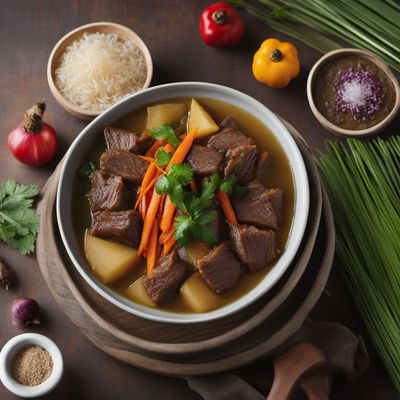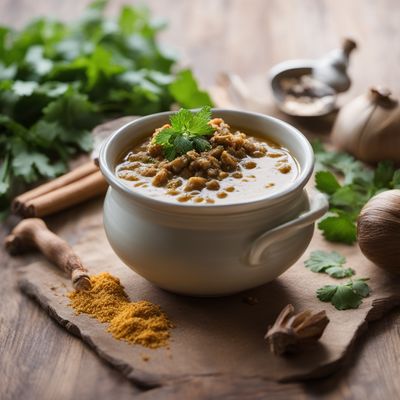
Ingredient
Turmeric roots
Golden Spice: Unveiling the Wonders of Turmeric
Turmeric roots are slender, knobby rhizomes that belong to the ginger family. They have a tough brown skin and a bright orange-yellow flesh that stains easily. Known for its earthy and slightly bitter taste, turmeric imparts a warm and peppery flavor to dishes, along with a vibrant golden hue. Its texture is firm and fibrous, requiring grating or grinding before use.
Origins and history
Turmeric has a rich history dating back thousands of years, originating in Southeast Asia and India. It has been used for centuries in Ayurvedic and traditional Chinese medicine for its medicinal properties. Turmeric also holds cultural significance in Hindu rituals and ceremonies. It later spread to the Middle East, Africa, and Europe through trade routes, becoming an integral part of various cuisines.
Nutritional information
Turmeric is a nutritional powerhouse, containing curcumin, a compound known for its anti-inflammatory and antioxidant properties. It is also a good source of manganese, iron, and vitamin B6. With only 29 calories per ounce, turmeric is a low-calorie ingredient that adds flavor and color to dishes.
Allergens
Turmeric may cause allergic reactions in some individuals, particularly those who are sensitive to ginger or yellow food dyes.
How to select
When selecting turmeric roots, look for firm and plump rhizomes with a vibrant orange-yellow color. Avoid any roots that appear shriveled, moldy, or have soft spots. Fresh turmeric should have a strong aroma and a slightly bitter taste. If purchasing ground turmeric, opt for reputable brands to ensure quality and freshness.
Storage recommendations
To maintain the freshness of turmeric roots, store them in a cool, dry place away from direct sunlight. If refrigerated, they can last for up to two weeks. Ground turmeric should be stored in an airtight container in a cool, dark place to preserve its flavor and potency.
How to produce
Turmeric can be grown at home by planting fresh turmeric rhizomes in well-draining soil and providing them with ample sunlight and water. It thrives in tropical and subtropical climates, but can also be grown indoors in containers.
Preparation tips
To prepare turmeric roots, scrub them thoroughly under running water to remove any dirt or debris. They can be grated, sliced, or ground into a fine powder using a mortar and pestle or a spice grinder. Turmeric is commonly used in curries, stews, soups, and marinades, adding both flavor and color to the dishes. It pairs well with ingredients like ginger, garlic, coconut milk, and citrus fruits. Additionally, turmeric can be used to make golden milk, a popular health drink.
Substitutions
Ginger can be used as a substitute for turmeric, although it has a slightly different flavor profile. Other alternatives include saffron, annatto, or curry powder, depending on the desired outcome of the dish.
Culinary uses
Turmeric is widely used in Indian, Southeast Asian, Middle Eastern, and African cuisines. It is a key ingredient in curries, spice blends, pickles, and rice dishes. Turmeric is also used to color and flavor mustards, cheeses, and various beverages.
Availability
Turmeric is commonly available in countries such as India, Bangladesh, Sri Lanka, Thailand, Indonesia, and Malaysia. It is also cultivated in parts of Africa, the Caribbean, and Central America.
More ingredients from this category
Recipes using Turmeric roots » Browse all

Vietnamese-style Gumbo
Phở-inspired Gumbo: A Fusion of Flavors

Yemeni-Style Cutturiedde with Spiced Lamb
Savory Spiced Lamb Cutturiedde: A Yemeni Delight

Chicken Tikka Masala
Italian-inspired Chicken Tikka Masala

Coto Makassar with a Twist
Savory Beef Stew with Indonesian Flair

Uzbek-inspired Lamb Pilaf with Dried Fruits and Nuts
Sultan's Delight: A Flavorful Journey through Uzbek Cuisine

Malaysian Indian Spiced Krachel
Savory Spice-infused Krachel: A Malaysian Indian Twist on Moroccan Delicacy

Papua New Guinean Inspired Vegetable Terrine
Harmony of Fresh Garden Vegetables: Papua New Guinean Terrine

Zanzibari Stuffed Bell Peppers
Spicy Delight: Zanzibari Stuffed Bell Peppers

Afghan-inspired Meat Pie Barm
Kofta-filled Naan Pocket: A Taste of Afghanistan

Melanesian Seafood Soup
Tropical Delight: Melanesian Seafood Soup

Denningvleis with Yellow Rice
Spiced Lamb Stew with Fragrant Yellow Rice

Tripuri Chorba Beïda
Creamy Tripuri Egg Soup